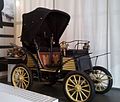Portal:Cars
The Cars PortalA car, or an automobile, is a motor vehicle with wheels. Most definitions of cars state that they run primarily on roads, seat 1-8 people, have four wheels, and mainly transport people rather than cargo. There are around 1.644 billion cars in use worldwide as of January 2025. The French inventor Nicolas-Joseph Cugnot built the first steam-powered road vehicle in 1769, while the Swiss inventor François Isaac de Rivaz designed and constructed the first internal combustion-powered automobile in 1808. The modern car—a practical, marketable automobile for everyday use—was invented in 1886, when the German inventor Carl Benz patented his Benz Patent-Motorwagen. Commercial cars became widely available during the 20th century. The 1901 Oldsmobile Curved Dash and the 1908 Ford Model T, both American cars, are widely considered the first mass-produced and mass-affordable cars, respectively. Cars were rapidly adopted in the US, where they replaced horse-drawn carriages. In Europe and other parts of the world, demand for automobiles did not increase until after World War II. In the 21st century, car usage is still increasing rapidly, especially in China, India, and other newly industrialised countries. Cars have controls for driving, parking, passenger comfort, and a variety of lamps. Over the decades, additional features and controls have been added to vehicles, making them progressively more complex. These include rear-reversing cameras, air conditioning, navigation systems, and in-car entertainment. Most cars in use in the early 2020s are propelled by an internal combustion engine, fueled by the combustion of fossil fuels. Electric cars, which were invented early in the history of the car, became commercially available in the 2000s and widespread in the 2020s. The transition from fossil fuel-powered cars to electric cars features prominently in most climate change mitigation scenarios. (Full article...) Entries here consist of Good and Featured articles, which meet a core set of high editorial standards.
 The Mitsubishi i (三菱・i, Mitsubishi i) is a kei car from automaker Mitsubishi Motors, first released in January 2006, twenty eight months after its debut at the 2003 Frankfurt Motor Show. It is the first four-door automobile since the 1960s to employ a "rear midship" setup with the engine behind the passengers, in an attempt to improve safety and interior space without enlarging the overall exterior. The innovative layout and styling of the i proved an immediate critical and commercial success, exceeding Mitsubishi's initial sales targets by 20 percent and winning thirteen awards in its first year. Although designed with the Japanese keijidōsha light automobile class in mind, the attention it generated led to its subsequent introduction in right hand drive markets in Asia, Oceania and Europe. It is also used as a basis of the 2009 i-MiEV battery electric vehicle. (Full article...) Selected article - Beam's Shell Service Station and Office, also known as C. Grier Beam Truck Museum, is a historic service station located at 117 N. Mountain St. in Cherryville, Gaston County, North Carolina. It was built about 1930 by the Shell Oil Company, and is a one-story, rectangular Mission/spanish Revival style building. Associated with the service station are the original pump island and gasoline pumps. The building features a brick water table and brick trim on a stuccoed construction. It was listed on the National Register of Historic Places in 1997. (Full article...) Selected picture of the day
Selected biography - Ferdinand Karl Piëch (German pronunciation: [ˈfɛʁdinant ˈpiːɛç] ⓘ; 17 April 1937 – 25 August 2019) was an Austrian business magnate, engineer, and executive who held the positions of chairman of the executive board (Vorstandsvorsitzender) of the Volkswagen Group from 1993 to 2002, and chairman of the supervisory board (Aufsichtsratsvorsitzender) from 2002 to 2015. A grandson of Ferdinand Porsche, Piëch began his career at Porsche before moving to Audi, where he was instrumental in transforming the brand into a formidable competitor to Mercedes-Benz and BMW, thanks to groundbreaking models like the Audi Quattro and the Audi 100. Trained as an engineer, Piëch had a profound impact on the design and engineering of several iconic vehicles, including the Porsche 911, Porsche 917, Audi Quattro, and most notably the Bugatti Veyron, which, as of 2012, held the title of the fastest, most powerful, and most expensive road-legal car ever produced. Due to his significant contributions to the automotive industry, Piëch was named "Car Executive of the Century" in 1999 and was inducted into the Automotive Hall of Fame in 2014. (Full article...) On this day November 2
Did you know...
Selected quote of the dayThe quality is remembered long after the price is forgotten —Sir Henry Royce TopicsGeneral imagesThe following are images from various car-related articles on Wikipedia.
CategoriesThings you can do to help If you wish to help, you can:
Associated WikimediaThe following Wikimedia Foundation sister projects provide more on this subject:
Discover Wikipedia using portals |
































































